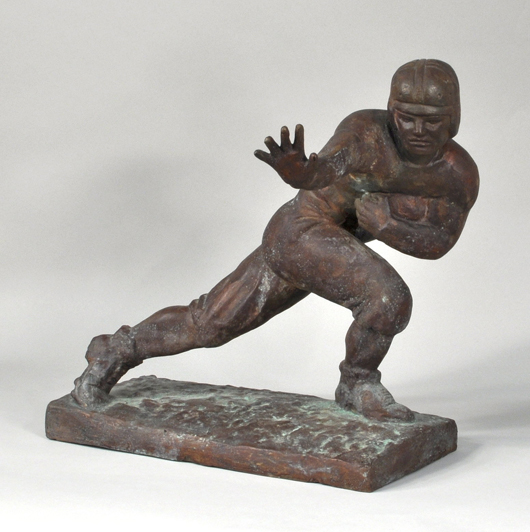
OKLAHOMA CITY (AP) – So what ever happened to the real Billy Sims Heisman Trophy?
Sure, the legendary Sooner running back sold the prestigious award — twice it turns out. But what happened then?
That remains a mystery.
The question came up again this year when an Arkansas sports memorabilia dealer admitted to creating a phony Sims Heisman Trophy and other fake merchandise to commit widespread fraud, The Oklahoman reports .
Last week, a judge in Chicago sentenced John Rogers to 12 years in federal prison for those schemes and others involving photo collections.
Rogers, 44, of North Little Rock, Arkansas, was ordered to pay $23.5 million in restitution to his victims.
Prosecutors told the judge the smooth-talking con man fooled customers, investors and bankers for years with his fake merchandise, phony contracts and “many, many lies” to fund an extravagant lifestyle.
The Heisman scheme worked because “it was well known in the memorabilia world” that Sims was one of the few award winners to have sold the trophy, prosecutors wrote in a sentencing memorandum to the judge. “So the fact that Rogers had obtained the trophy was not surprising to the investors.”
Rogers pleaded guilty in March to a single wire fraud offense involving the phony Heisman but he admitted to the other schemes, too. At his sentencing last week, U.S. District Judge Thomas Durkin called the scope of the fraud breathtaking.
“You literally told thousands of lies to honest people to have them part with their money,” the judge said, according to a Chicago Tribune news account.
Prosecutors alleged Rogers defrauded “multiple individuals” with the phony Heisman Trophy, including one investor in 2011, one in 2012 and two in 2014.
Rogers pledged the phony trophy as collateral on loans, and his investors gave him money based on his false representations, according to prosecutors. One gave $100,000 after being told the trophy was valued as high as $225,000.
Rogers created the phony Heisman using an honorary one given in 1960 to the longtime emcee of the annual banquet. He admitted to paying $50,363 for the honorary Heisman in 2009 and to getting a trophy shop to make a Sims’ nameplate.
Sims won his Heisman in 1978 when he was a junior at the University of Oklahoma. He came in second for the award the next year.
He then played professionally for the Detroit Lions until a knee injury in 1984.
Sims is now involved in a successful chain of barbecue restaurants. He first sold his Heisman in 1995 during a dark time in his life. A series of bad business deals cost him millions of dollars and left him bankrupt.
Buying the Heisman and other awards from his college and pro days was a Texarkana, Texas, businessman, Bob White.
White had been like a father to Sims when Sims was growing up in nearby Hooks, Texas. “Bob took care of Billy,” former Sooner coach Barry Switzer recalled last week.
White paid $50,000 for the items. Their one-page 1995 agreement stated Sims “has the right to repurchase these items for the original price” plus 8.5 percent interest.
White said he let Sims borrow the Heisman from time to time for autograph signings and other events to try to make money. One time, Sims didn’t bring the trophy back.
White kept expecting the trophy to be returned. He found out later — from a news story — that Sims had sold the trophy again.
Buying it the second time was a sports memorabilia dealer, Scott Goodman.
White sued to try to get it back. He and Goodman fought it out in courts in Texas and Florida for years. White lost.
Goodman said in 2001 in a deposition that he bought the trophy from Sims for $88,000 at a Dallas restaurant in June 2000.
“He was hurting. His kids needed money for college,” Goodman said.
Goodman said he didn’t know about White’s claim on the trophy. He said he resold it for its fair market value.
“I don’t know where it is,” Goodman said in the 2001 deposition. “I was a broker.”
Years ago, an insurance adjuster called White about the trophy.
“He said, ‘Well, it’s been reported stolen … A wealthy family in a large home in Chicago was burglarized and they stole it and some more things … We’re just trying to locate it,”’ White recalled last week. “That’s the last thing I heard.”
In interviews with reporters over the years, Sims has made conflicting statements about his Heisman’s fate. Often he simply says he has it again. Last June, at a restaurant opening in Kansas, he said he’s “working on getting the trophy back,” The Kansas City Star reported.
The Oklahoman asked him about his trophy earlier this month while he was in New York City for this year’s Heisman ceremony.
“Do you mean do I know where it is?” Sims replied. “Yes, I know where it is. My mother is using it for a door opener today in St. Louis, Missouri. That’s where it is.”
___
Information from: The Oklahoman, http://www.newsok.com
By NOLAN CLAY, The Oklahoman
Copyright 2017 Associated Press. All rights reserved. This information may not be published, broadcast, rewritten, or redistributed.


